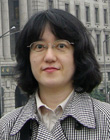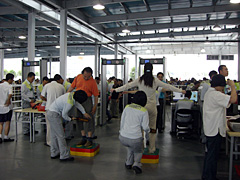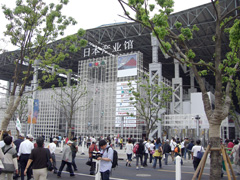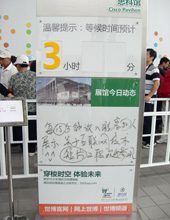Top>Opinion>Can Shanghai Change China?
 Index
Index

Yasuko Enomoto [Profile]
Can Shanghai Change China?
Yasuko Enomoto
Professor, Faculty of Letters, Chuo University
Areas of Specialization: Chinese Modern Cultural History and Comparative Culture
For me, having studied modern cultural history in Shanghai, the Shanghai Expo opening in May of this year is quite something to observe, in that it is a milestone in the modern era of China. Though I was often asked how the Shanghai Expo would change China just after its opening, my honest answer was I don't know. This is because the modern era in Shanghai is very unique even when compared to China as a whole, and it has taken many twists and turns for 160 years up to now.
Shanghai, which had flourished especially around the settlements by western powers since the middle of the nineteenth century, achieved its highest prosperity in the 1930s. As a trade and manufacture town, or a huge financial center linked with the Asian and even global economy, Shanghai was a metropolis that had a more enormous presence than Tokyo. This situation, however, drastically changed in 1949, when the People's Republic of China was founded. The Chinese Communist government converted all the wealth that Shanghai had accumulated into national property, and further rejected investments from foreign countries. During the Great Cultural Revolution that began in 1966 and lasted for ten years, Chinese economic activity stagnated as a whole, and all bourgeois things or ideas were absolutely rejected. Shanghai people sealed the glorious memories of the once Great Shanghai in the deep recesses of their mind.
Even after China's reform policy of opening up to the outside world started in the late 1970s, Shanghai lagged far behind Guangzhou and Shenzhen because the reform initially focused on Guangdong province. It was in 1992 when Deng Xiaoping made his so-called southern tour that attention was brought back to Shanghai. To attract investment from overseas that had declined since the Tiananmen Square incident in 1989, Deng traveled through several southern cities in China. He then regretted that he had not designated Shanghai as a special economic zone earlier. It was not until Deng ordered development in the Chang Jiang delta area including Shanghai that Shanghai's potential—that is, the past glorious memories and valuable experience—were revived.
The skyscrapers that we see now in the Shanghai Pudong area were built in less than 20 years after the southern tour was made. Now, Shanghai has been restored to the glory it enjoyed in the settlement period. Just at this time, the long awaited Expo is held in Shanghai. It goes without saying that the Shanghai Expo is a great enterprise of national prestige comparable in scale to the Beijing Olympics.

Body search at the entrance gate
On the Japan Day on June 12, I took an opportunity to visit the Expo venue. Though I fortunately had a reservation through an acquaintance who is a staff member for an Expo related event (the Expo Celebratory China-Japan Famous Theater Actor Performance), I waited at the front of the entrance gate for one hour, and waited for another two hours before entering the Japanese Industry Pavilion (I also had to stand the whole time). It was a veritable test of stamina. Since it was a Saturday starting a holiday weekend which continued through the three-day holiday for the Duanwu Festival of the Chinese calendar, which started on the following Monday, the venue was crowded with many tourists from all over China. Their uplifting feeling and excited loud voices exceeded all expectations. I wondered what made them so enthusiastic, and I couldn't believe my ears when I heard the longest time for which visitors waited for popular pavilions so far—nine hours.
Actually, the general public was not allowed to visit the Japan Pavilion because of the attendance of Former Prime Minister Hatoyama on that day. I managed to enter the pavilion in my capacity as an event participant. The Japanese Industry Pavilion, which was jointly funded by several companies and municipalities, is famous for its attached restaurant, where Kaiseki dishes worth three thousand yuan (about forty thousand yen) per person are served. Though I failed to eat such high-class dishes, I was much interested in the video that was presented in the beginning at the pavilion to introduce contemporary Japan. Under the theme of Kirei, Kawaii, Kimochiii (Comely, Cute, and Comfortable), the film begins with a close-up view of the Makunouchi-bento (Japanese typical lunch box), where white rice and red umeboshi (pickled plum) are associated with the national flag of Japan. Following this, it shows us beautiful scenery such as cherry blossoms and autumn leaves, the latest fashion of the young in Shibuya and Harajuku, and systematically operated trains and road networks. It reminded me once again that these were Japan's unique features.

Japan Industry pavilion
This Expo held under the theme of Better City, Better Life is well suited to Shanghai, which developed unique urban culture during the settlement period and has inherited its legacy. People in Shanghai flourished in water transport even before foreign countries forced China to open the port, and they had a progressive spirit. To such people, foreigners living in settlements were great interest, providing new things. In Shanghai in the early twentieth century, Chinese culture and Western culture were mixed in food, clothing, and shelter, and in all kinds of entertainment. For example, traditional loose-fitting clothes were replaced with tight-fitting Chinese dresses, and young couples went to the Hollywood movies by rickshaw, creating a unique scene called Shanghai Modern.
In spite of some twists and turns in the late twentieth century as described above, Shanghai made a comeback as a leading economic city in China. Their lifestyle has been considerably improved. Every time I went to Shanghai over the last ten years, I noticed that TV commercials advertizing luxury foreign cars and villas had an increasing sense of reality, where they once seemed like an unattainable dream. People have demonstrated their wealth by obtaining durable goods. The question, then, is what they will seek next. I think it is the improvement of their quality of life. Since the sense indicated by Japan's theme Kirei, Kawaii, Kimochiii is closely connected to their daily lives, it is no doubt that this theme appeals to the Chinese sense of values, which once tended to focus on appearance.

Notice saying three-hour wait
Looking back on history, Shanghai has been a window into which a foreign breeze is blowing ever since the settlement period, and it further served as a show window which presents those goods uniquely developed from the mixture of domestic and international cultures to a Chinese national. People coming from various places in vast China encounter a new culture in Shanghai and then bring it back to their hometowns. Information and things disseminated directly from hand to hand have brought about different effects from those advertised or promoted by the government, and this will continue going forward as well.
Shanghai has served as an engine for modernization in China. In China, where there are large disparities among regions, it is of great significance for millions, or even tens of millions of people to visit Shanghai on the occasion of the Expo. I believe the leading edge urban lifestyle demonstrated in and around the venue will awaken a desire inside each visitor. The future of China may very well change from right here.
- Yasuko Enomoto
Professor of Chinese Modern Cultural History and Comparative Culture on the Faculty of Letters at Chuo University - The author was born in Tokyo in 1968, and received her doctorate from the doctoral program (comparative literature and culture) in the Graduate School of Arts and Sciences at the University of Tokyo. After working as an assistant in the Graduate School of Arts and Sciences at the University of Tokyo, and as a full-time lecturer and then assistant professor in the Institute for Language and Culture at Doshisha University, she was appointed assistant professor in the Faculty of Letters at Chuo University in 2004, and then professor there in 2008. She studies Chinese modern cultural history, devoting particular attention to music. Her book Musician's City, Shanghai (Kenbunshuppan, 1998) was awarded the Suntory Arts Award and the Japan Comparative Literature Association Award. Her other works include Story about Orchestra in Shanghai (Shunjusha Publishing Company, 2006), Shanghai: A Century of a Multinational City (Chuokoron Shinsha, Inc., 2009), and Listen to Sound Other Than Bowstring: Father's Letters to His Pianist Son (an abridged translation of Fu Lei's Family Letters, Kinohanasha Publishing Co., Ltd., 2004).
- Research Activities as a Member of Research Fellowship for Young Scientists (DC1), Japan Society for the Promotion of Science (JSPS) Shuma Tsurumi
- Important Factors for Innovation in Payment Services Nobuhiko Sugiura
- Beyond the Concepts of Fellow Citizens and Foreigners— To Achieve SDGs Goal 10 “Reduce Inequality Within and Among Countries” Rika Lee
- Diary of Struggles in Cambodia Fumie Fukuoka
- How Can We Measure Learning Ability?
—Analysis of a Competency Self-Assessment Questionnaire— Yu Saito / Yoko Neha - The Making of the Movie Kirakira Megane








